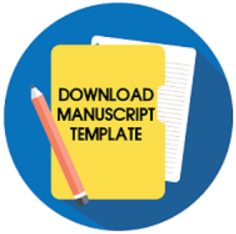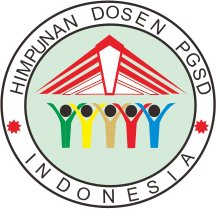Science Digital Library: Innovation in Improving Science Literacy of Elementary School Students
Downloads
The results of the initial study conducted at Sidoharjo 1 Elementary School found problems that caused the low science literacy of grade VI students. These problems include inappropriate teaching materials, less contextualized science learning, inadequate science learning media, and a lack of motivation for students to learn science. The purpose of this research is to develop a Science Digital Library that can improve science literacy. The method used in this research is the research and development of the ADDIE model with the stages of Analyze, Design, Develop, Implement, and Evaluate. The research subjects were 21 sixth-grade students of Sidoharjo 1 Elementary School. Data collection techniques are media and material expert validation, student response questionnaires, and tests. The results of the study were that media experts and material experts validated the Science Digital Library. The results of the media validation were 88% with very valid qualifications, while the material validation was 92% with very valid qualifications. Science literacy assessment instruments measure science literacy skills. The improvement was calculated by the normalized gain formula (g) with the result of 0.71. The result of this study is that the Science Digital Library is proven to be feasible and valid for use and can improve science literacy in grade VI students of Sidoharjo I Elementary School.
Downloads
Abidin, Y., Mulyati, T., & Yunansah, H. (2017). Developing literacy learning model based on multi literacy, integrated, and differentiated concept at primary school. Cakrawala Pendidikan, 36(2). https://doi.org/10.21831/cp.v36i2.13283
Arianto, M. S., & Subhan, A. (2012). Issues of digital library development in Indonesia. Repository UIN Suka. https://digilib.uin-suka.ac.id/id/eprint/7051/
Aripin, F. Y., & Ikrom, F. D. (2022). Efforts to Improve Science Literacy Skills Using Elementary School Students' ICT Flash Media. Jp3M, 3(3). https://jurnal.upg.ac.id/index.php/jp3m/article/view/270
Arum, A. P., & Marfianti, Y. (2021). Development of digital libraries to facilitate access to information. Information Science and Library, 2(2). https://doi.org/10.26623/jisl.v2i2.3290
Astuti, F. K., Cahyono, E., Supartono, S., Van, N. C., & Duong, N. T. (2018). Effectiveness of elements periodic table interactive multimedia in Nguyentat thanh high school. IJIET: International Journal of Indonesian Education and Teaching, 2(1), 1–10. https://doi.org/10.24071/ijiet.v2i1.951
Azimi, Rusilowati, A., & Sulhadi. (2017). Development of science learning media based on science literacy for elementary school students. Pancasakti Science Education Journal, 2(2), 145-157. http://e-journal.ups.ac.id/index.php/psej
Budhi, N. W. S. (2021). Optimizing digital services in the new normal era. Acarya Pustaka: Jurnal Ilmiah Perpustakaan dan Informasi, 8(1). https://doi.org/10.23887/ap.v8i1.39793
Caffrey, C., Lee, H., Withorn, T., Galoozis, E., Clarke, M., Philo, T., Eslami, J., Ospina, D., Haas, A., Kohn, K.P., Macomber, K., Clawson, H. and Vermeer, W. (2023). Library instruction and information literacy 2022. Reference Services Review, 51(3/4), 319-396. https://doi.org/10.1108/RSR-08-2023-0061
Dewi, A. O. P. (2019). Use of mobile library for digital library. Anuva: Jurnal Kajian Budaya, Perpustakaan, dan Informasi, 3(2). https://doi.org/10.14710/anuva.3.2.151-155
Fadhli, K., Nasrulloh, M. F., Huda, M. F., Latifah, S., C, B. W., Putri, S. E., & Prasasti, M. A. (2023). Improving Student Literacy through Edugames with Mading Art Question. Jumat Pendidikan: Jurnal Pengabdian Masyarakat, 4(1). https://doi.org/10.32764/abdimaspen.v4i1.3378
Fananta, M. R., (2017). Supporting Materials for Scientific Literacy. Jakarta: Kementrian Pendidikan Nasional. [Online]: diakses pada 13 Maret 2022, pukul 17.18 WIB. Tersedia di https://gln.kemdikbud.go.id/glnsite/wp-content/uploads/2017/10/cover-materi- pendukung-literasi-sains-gabung.pdf
Fuadi, Husnul, Robbia, Zulkri, A., Jufri, & Wahab, A. (2020). Analysis of Factors Causing Low Scientific Literacy Skills of Students. Jurnal Ilmiah Profesi Pendidikan, 5(2), 108-116. https://doi.org/10.29303/jipp.v5i2.122
Gofar, Abdul. (2019). Development of multimedia for learning islamic religious education to improve student learning outcomes at SMP IT Bina Insani Kayuagung, Ogan Komering Hilir Regency. Jurnal Dialektologi, 4(1).https://ejournal.uniski.ac.id/index.php/Dialektologi/article/download/301/250
Griffin, Karin, L., and Ramachandran, Hema. (2014). Science Education and Information Literacy: A Grass-Roots Effort to Support Science Literacy in Schools. UK: Science and Technoogy Libraries. https://doi.org/10.1080/0194262X.2010.522945
Gunawan, Suhardi, & Makawawa, J.C.(2023). Developing picture storybook learning media in terms of students' critical and creative thinking skills. Jurnal Prima Edukasia, 11(2), 161-175. doi: http://dx.doi.org/10.21831/jpe.v11i2.56795
Habibillah, A. (2022). Development of digital library to increase reading interest of students of Rantau Bayur Palembang 8 Elementary School. Jurnal Ilmu Komputer , 3(1). https://doi.org/10.56869/klik.v3i1.340
Hayatuddiniyah, H. (2021). Digital libraries based on the perspective of lucy. Pustaka Karya: Jurnal Ilmiah Ilmu Perpustakaan dan Informasi, 9(1). https://doi.org/10.18592/pk.v9i1.5141
Hestiana, H., & Rosana, D. (2020). The effect of problem based learning based sosio-scientific issues on scientific literacy and problem-solving skills of junior high school students. Journal of Science Education Research, 4(1), 15-21. https://doi.org/10.21831/jser.v4i1.34234
Holden, I. (2012). Predictors of Students' Attitudes toward Science Literacy. Communications in Information Literacy, 6(1), 107-123. https://doi.org/10.15760/comminfolit.2012.6.1.121
Hotimah & Muhtadi, A. (2017). Development of interactive science learning multimedia to improve students' understanding of microorganism material in middle school. Jurnal Inovasi Teknologi Pendidikan, 4(2), 201-213. DOI: https://doi.org/10.21831/jitp.v4i2.15047
Husna, A. N., Yuliani, D., Rachmawati, T., Anggraini, D. E., Anwar, R., & Utomo, R. (2021). Digital literacy program for social inclusion-based library development in Sedayu Village, Muntilan, Magelang. Community Empowerment, 6(2). https://doi.org/10.31603/ce.4259
Husnawati, H., Italiana, F., Zariyatul, Z., & Budiarti, E. (2022). Efforts to develop early childhood literacy with digital libraries. JIIP: Jurnal Ilmiah Ilmu Pendidikan, 5(6). https://doi.org/10.54371/jiip.v5i6.628
Indarto, N. (2017). Analysis of School Literacy Movement (GLS) to Improve Reading Ability of Grade IV Students of SDN Tlogomas IV at SDN Tlogomas 1 Malang. Universitas Muhammadiyah Malang. http://eprints.umm.ac.id/37225/
Indaryati dan Jailani. (2015). Development of comic media for mathematics learning to increase motivation and learning achievement of fifth grade students. Jurnal Prima Edukasia, 3(1), 84-96. Retrieved from https://journal.uny.ac.id/index.php/jpe/article/view/4067/3521
Kemendikbudristek. (2023). Indonesia's Ranking in PISA 2022 Increases by 5-6 Positions Compared to 2018. GTK Kemendikbud. https://www.kemdikbud.go.id/main/blog/2023/12/peringkat- indonesia-pada-pisa-2022-naik-56-posisi-dibanding-2018
Kemendikbudristek. (2023). Pisa 2022 and Learning Recovery in Indonesia. Learning Recovery Indonesia. https://lpmpdki.kemdikbud.go.id/pisa-2022-dan-pemulihan-pembelajaran-di- indonesia/
Latif, A. & Faisal, A. (2021). Efforts to improve students' science literacy through computer- based science learning media. Jurnal Pendidikan Universitas Garut, 15(1), 444-452. https://journal.uniga.ac.id/index.php/JP/article/view/1179/0
Latip, A., & Faisal, A. (2021). Efforts to Improve Students' Science Literacy through Computer-Based Science Learning Media. Jurnal Pendidikan UNIGA, 15(1). https://doi.org/10.52434/jp.v15i1.1179
Martani, K. D. (2020). Implementation of digital book learning media using anyflip application to improve the quality of indonesian language learning in identifying intrinsic elements of stories of fourth grade students of Bagusan Elementary School, Parakan District, Temanggung Regency. JP3: Jurnal Pendidikan Dan Profesi Pendidik, 6(1). https://doi.org/10.26877/JP3.V6I1.7296
Maryani, Ika dan Zia Sumiar. (2018). Developing science monopoly on the force learning material for elementary school students. Jurnal Prima Edukasia, 6(1), 11-20. Retrieved from https://journal.uny.ac.id/index.php/jpe/article/view/16084/pdf
Nesbit, J., Belfer, K., & Leacock, T. (2009). Learning Object review Instrument (LORI) User Manual. Nuevos Sistemas de Comunicación e Información.https://www.academia.edu/7927907/Learning_Object_Review_Instrument_LORI_
Niari, R. (2023). Implementation of the digital library program at Methodist School 2 Palembang. Educational : Jurnal Inovasi Pendidikan & Pengajaran, 3(1). https://doi.org/10.51878/educational.v3i1.2064
Noprianto, E. (2018). Challenges in realizing digital libraries. Pustakaloka, 10(1). https://doi.org/10.21154/pustakaloka.v10i1.1212
OECD. (2013). PISA 2012 Results in Focus: What 15year-olds know and what they can do with what they know. New York: Columbia University. https://www.oecd.org/pisa/keyfindings/pisa-2012- results-volume-I.pdf
OECD. (2016). PISA 2015 Results in Focus. New York: Columbia University. https://www.oecd.org/pisa/pisa-2015-results-in-focus.pdf
Prasetya, C., Pratiwi, I. B., & Maisarah. (2023). Analysis of the improvement of science literacy and critical reasoning skills of students using Liveworksheet teaching materials. Katalis: Jurnal Penelitian Kimia dan Pendidikan Kimia, 6(2). https://doi.org/10.33059/katalis.v6i2.8820
Prasetyo, A. A. (2019). The impact of the digital era on libraries as an effort to attract the millennial generation. Tibanndaru : Jurnal Ilmu Perpustakaan Dan Informasi, 3(2). https://doi.org/10.30742/tb.v3i2.761
Prasetyo, G., & Prasojo, L. (2016). Development of Adobe Flash in integrative thematic learning based on scientific approach, sub-theme of the beauty of historical heritage. Jurnal Prima Edukasia, 4(1), 54 -66. Retrieved from http://journal.uny.ac.id/index.php/jpe/article/view/7788
Pujana, L. A., Dwijayanti, I., & Siswanto, J. (2022). Development of teaching materials based on the clis learning model akm series to improve elementary school students' science literacy skills. Pendas : Jurnal Ilmiah Pendidikan Dasar, 7(2). https://doi.org/10.23969/jp.v7i2.6565
Puspita Sari, N. (2022). Implementation of the CCL model as a learning solution in improving elementary school students' science literacy. Jurnal Pendidikan Dan Kewirausahaan, 11(1). https://doi.org/10.47668/pkwu.v11i1.666
Rafi Ramadhan. (2023). Digital library management at the regional library and archives agency of West Java Province. Jurnal Pustaka Budaya, 10(1). https://doi.org/10.31849/pb.v10i1.11270
Rohmaya, N. (2022). Improving Students' Science Literacy Through the Use of Interactive E-Lkpd in the Context of Socioscientific Issues. Madaris: Jurnal Guru Inovatif, 2(1), 83-92. https://jurnalmadaris.org/index.php/md/article/view/301
Salsabila, A., Agustina, K., & Febriani, A. E. (2023). Developing a digital library to build active discussions in the metaverse. LibTech: Library and Information Science Journal, 4(1). https://doi.org/10.18860/libtech.v4i1.21902
Santika, A., & Sylvia, I. (2021). Effectiveness of anyflip-based e-module to improve students' material mastery ability in social values and norms material for class x at Payakumbuh 3 High School. Jurnal Sikola: Jurnal Kajian Pendidikan dan Pembelajaran, 2(4). https://doi.org/10.24036/sikola.v2i4.128
Septiana, A. I., Anggraini, D., & Syawanodya, I. (2020). Interactive multimedia development using hologram pyramids for learning media on spatial structures in elementary schools. Jurnal Instek Infromatika Saint Dan Tekonologi, 5(2). https://doi.org/10.24252/instek.v5i2.16370
Sulthon, M., Pujiastuti, P., & Retnawati, H. (2021). What is the teacher's challenge on the developing of learning media to increase critical thinking ability and the character? Jurnal Prima Edukasia, 9(1), 55-64. https://doi.org/10.21831/jpe.v9i1.34876
Ulfa, L., Rusilowati, A., Nugroho, S.E. (2017). Profile of students' science literacy skills on environmental pollution and global warming material. Jurnal Pendidikan Matematika dan Sains, 4(2). 163-169. https://journal.uny.ac.id/index.php/jpms
Utami, W. T. P., & Trisnani, N. (2021). Development of augmented reality-based fairy tales as literacy materials during the pandemic. Taman Cendekia: Jurnal Pendidikan Ke-SD-An, 5(2). https://doi.org/10.30738/tc.v5i2.11080
Wahdah, S. (2020). Digital libraries, digital collections and copyright law. Pustaka Karya : Jurnal Ilmiah Ilmu Perpustakaan dan Informasi, 8(2). https://doi.org/10.18592/pk.v8i2.5132
Wahyudi, A. (2018). Analysis of android-based digital library development using the scrum method. Faktor Exacta, 11(2). https://doi.org/10.30998/faktorexacta.v11i2.2484
Wahyuni, N. R., & Kurniawan, H. (2022). Creating a digital library using the rapid application method at Tanjungpinang 1 High School. JuTI: Jurnal Teknologi Informasi, 1(1). https://doi.org/10.26798/juti.v1i1.583
Widya, W., Zaturrahmi, Z., Muliani, D. E., Indrawati, E. S., Yusmanila, Y., & Nurpatri, Y. (2021). Training in making digital teaching materials using the kvsoft flipbook application and anyflip web at Padang 41 High School. Jurnal Pengabdian Masyarakat Multidisiplin, 4(3), 183–189. https://doi.org/10.36341/JPM.V4I3.1865
Wulandari, N. & Sholihin, H. (2016). Analysis of scientific literacy ability in the aspects of knowledge and scientific competence of junior high school students on heat material. Edusains, 8(1), 66-73. https://doi.org/10.15408/es.v8i1.1762
Yusmar, F., & Fadilah, R. E. (2023). Analysis of low scientific literacy of indonesian students: pisa results and causal factors. Lensa: Jurnal Pendidikan IPA, 13(1). https://doi.org/10.24929/lensa.v13i1.283
The copyright of the received article shall be assigned to the journal as the publisher of the journal. The intended copyright includes the right to publish the article in various forms (including reprints). The journal maintains the publishing rights to the published articles.

Jurnal Prima Edukasia by http://journal.uny.ac.id/index.php/jpe/index is licensed under a Creative Commons Attribution-ShareAlike 4.0 International License.


























